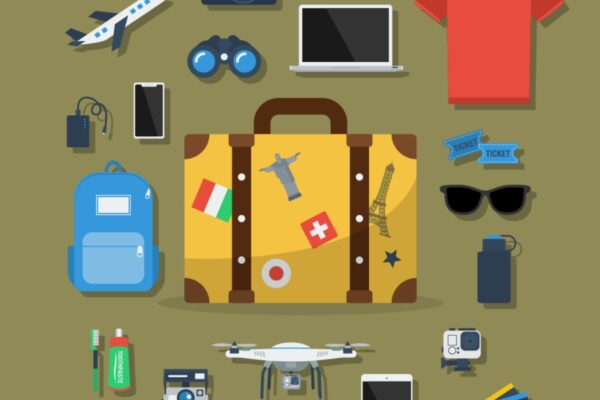
With each passing year, travel can seem both easier–and harder. This 2024 travel packing list is a handy tool when deciding what to pack.
It’s getting easier because there are now ebooks to replace stacks of bulky novels and travel guides, cheap travel phones and SIM cards so you can use your phone abroad without paying international calling fees, and internet almost everywhere you go in case you need to check up on directions or do a quick translation of some mystery food on the menu.
And it’s getting harder because carry-on restrictions are tightening and airlines are steadily chipping away at baggage allowances until checking a suitcase can cost more than booking your own seat on the plane.
Your packing list needs to adapt with the times. This 2024 travel packing list is perfectly designed to help you remember what you need–and leave behind what you don’t. Travel will be seamless with the right apps, technologies, and clever systems of packing to minimize weight and hassle.
Knowing what to pack will make all the difference when you travel. We’ve created downloadable travel packing checklists for you to print out and have handy when you’re packing your suitcase!

If you are traveling for a ski holiday, add these items to the Ultimate Packing List:

If you plan on backpacking, add these items to the Ultimate Packing List:

If you are planning to visit a beach during your holiday, add the below to the Ultimate Packing List:
Traveling with young children is a whole different scenario than traveling with older children, and requires parents to decide carefully what belongs in checked baggage versus carry-on.
Add the below carry-on list to the Ultimate Packing List. Note that carry-on liquid restrictions do not apply to infant formula.

There are several keys to packing for seamless travel. A few of these will help every traveler, while others are leveling-up strategies for frequent travelers who are willing to invest in the best possible travel experience.
There’s nothing worse than re-purposing a bag you use elsewhere, only to discover when going through the security check that your favorite pocket knife was tucked away in a hidden compartment.
There’s no point filling your suitcase with 20 pairs of socks if you can wash clothes once a week and save the extra luggage space for clothes that actually matter.
99% of the time it won’t, but if you take everything that would be a major hassle to replace in your carry-on baggage, a permanently lost suitcase will be less of a disaster. This definitely includes all valuables, but can also include things like uncommon charging cables; any paperwork about your trip such as an itinerary, printed booking confirmations, or a travel guide; and essential equipment if you are traveling for a sporting event or similar. If you have extra space, you can even take a change of clothes in your carry-on bag.
Unless you are traveling to a snowy place in winter, you are better off with many lighter layers than one heavy coat. This saves on space and gives you more versatility to dress for varying temperatures.
If reaching your accommodation involves climbing stairs or walking down the narrow cobblestone lanes typical of old European cities, consider a suitcase or duffle bag with backpack straps. If that isn’t an option, use a backpack as your carry-on bag, leaving your hands free to carry your suitcase where necessary.
Especially if your itinerary has you moving from one place to another every day or two, your clothes may never leave your suitcase. This means clothes that migrate to the bottom are likely to remain there until you return home. The less you bring, the more likely you are to actually use what you have.
A pair of comfortable city walking shoes with good grip can double as hiking shoes (just don’t choose white shoes!). For women, a sarong or similar wrap can work as a summer dress or skirt, a swimsuit cover-up, a beach towel, and a headscarf. A pair of lightweight black hiking pants can pass as nice slacks when paired with a dressier shirt. A Kindle can hold both your travel guides and your leisure reading material. And the most versatile of all, a Smartphone can be your camera, your GPS, and your translator.
This can save you a hefty amount on baggage fees, and it streamlines the process at both ends of the flight. Packing for only carry-on takes more planning than usual–see below for additional packing tips if you want to do away with your checked bags.
Not every accommodation with a washing machine has a dryer, so you may occasionally need to hang your clothes to dry. And if you get caught in an unexpected rainstorm or decide to go for a swim on a hot day when you left your swimsuit behind, you won’t want to pack away soggy clothes.
This is especially handy for frequent travelers who pack carry-on only, because often your favorite brands of shampoo, conditioner, lotion, or makeup won’t be available in carry-on-sized containers.
For travelers on a short getaway, or frequent fliers hoping to save on ever-increasing checked baggage fees, packing carry-on luggage only is a smart way to go. However, it requires a bit more planning than usual–and a minimalistic attitude toward luggage. Here’s how to decide what to pack for carry-on only.
If you are flying multiple airlines, purchase a soft duffel bag based on the dimensions of the most restrictive airline. This will allow you to cram in extra luggage and still fit your bag in the measuring basket if the airline checks.
Wear your heaviest or bulkiest shoes on the flight.
If you need to bring a large or heavy coat, wear it (or carry it over your arm).
Bring as many multi-purpose items as possible.
If you’re traveling for more than a couple days, plan to do laundry frequently so you can get by with only a few pairs of socks and underwear.
Check what toiletries your accommodation provides and leave behind any duplicates.
If it is too heavy or too bulky, see if you can remove a few items of clothing or purchase certain toiletries once you arrive.
If you’re struggling to stay below a carry-on weight limit, put your heaviest items in a collapsible bag or supermarket bag that can count as your “personal item”, especially if you’re struggling to stay below a carry-on weight limit. Airlines almost never weigh the personal item, just the large carry-on suitcase, backpack, or duffel bag.
Get in line for boarding as early as possible, so you can be sure of finding space for your luggage in the overhead compartment. Some airlines frequently offer a free gate-check option for carry-on bags; others may force you to pay to check your bag if you can’t find space in the overhead bins and it slightly exceeds carry-on restrictions. (Yes, you can get too-large or too-heavy bags onto planes, but you’ll be caught out with hefty fees eventually.)
Put all valuables and breakables in your “personal item” bag for under-seat storage, and your less important luggage such as clothes in the large carry-on bag stored in the overhead compartment.

Weather in New Zealand is very changeable, so bring layers even in the height of summer.
The sun in New Zealand is more intense than most other places in the world (due to the proximity of the ozone hole), so consider wearing a lightweight long-sleeve shirt for sun protection, as sunscreen may not be sufficient.
Tapwater in New Zealand is clean and safe for drinking, so bring a reusable water bottle for filling up at your accommodation.
Many accommodations in New Zealand are built into steep hillsides, and a surprising number do not have elevators, so a suitcase or duffel bag with backpack straps is very useful.
Several parts of New Zealand receive heavy rain no matter the season, so bring a good raincoat and umbrella. If you plan to hike for several hours in a rainy area, rain pants might also be a good idea.
Phone service is patchy in remote areas of New Zealand, so plan accordingly when navigating. Maps.Me works even with no phone service, while Google Maps may not.
Credit cards can be used almost everywhere in New Zealand, so cash is hardly ever necessary (except in the case of roadside stalls or farmers’ markets).
New Zealand uses 240-watt power and angled 2-prong or 3-prong plugs.
Contact your personal New Zealand Travel specialist today...






Contact us: +64 3 443 2111
E: info@newzealandskipackages.com
Hours: Mon–Sat, 9am-5pm (NZDT)